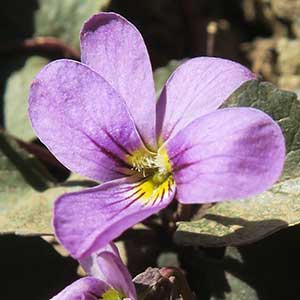Viola flettii
Viola subsinuata
Flett's violet, Olympic violet, rock violet
early blue violet, wavy-leaf violet, wood violet
1–3, ascending to erect, mostly glabrous, on caudex from fleshy rhizome.
basal and cauline;
basal: 1–3;
stipules linear-lanceolate, margins entire or with glandular processes, apex acuminate;
petiole 1.5–9.7 cm, mostly glabrous;
blade purple-tinted and –veined, broadly reniform to ovate, 0.9–2.4 × 1.2–4 cm, base cordate, margins finely crenate-serrate, eciliate, apex acute to obtuse, surfaces glabrous or sparsely pubescent along veins adaxially;
cauline similar to basal except: stipules ovate to lanceolate, margins entire or shallowly laciniate;
petiole 0.7–5.9 cm, usually glabrous;
blade 0.8–2.1 × 1.2–3.1 cm.
basal, 2–11, ascending to erect;
stipules linear-lanceolate, margins entire, apex acute;
petiole 5–25 cm, glabrous or pubescent;
mid-season leaf blades incised or lobed throughout, earliest leaf blades lobed (plants homophyllous), similar to mid-season blades, blade 5–9(–16)-lobed, sinuses usually narrower, shallower toward leaf base, middle and lateral blade lobes differ in width and/or shape, middle lobes narrowly deltate to narrowly elliptic, lateral lobes narrowly elliptic, lanceolate, or falcate, 1–11 × 1–12 cm, base truncate to cordate, margins entire or crenate, ciliate or eciliate, apex acute, mucronulate, surfaces usually pubescent throughout or on veins.
1.8–7.1 cm, usually glabrous.
5–15 cm, glabrous or pubescent.
sepals lanceolate, margins eciliate, auricles 0.5–1.5 mm;
petals soft reddish violet on both surfaces, all with yellow area basally, lower 3 dark violet-veined, lateral 2 bearded, lowest with white around yellow area, 10–15 mm, spur yellow, gibbous, 0.5–2 mm;
style head bearded; cleistogamous flowers axillary.
sepals lanceolate to ovate, margins ciliate or eciliate, auricles 1–2 mm;
petals light to dark blue-violet on both surfaces, lower 3 and upper 2 sometimes purple-veined, lateral 2 bearded, lowest sometimes bearded, 15–25 mm, spur color same as petals, gibbous, 2–3 mm;
style head beardless; cleistogamous flowers on prostrate to ascending peduncles.
± spherical, 5–9 mm, glabrous.
ellipsoid, 8–12 mm, glabrous.
dark brown to brownish purple, 2.5–3 mm.
beige, mottled to bronze, 1.5–2.5 mm.
= 54.
Viola flettii
Viola subsinuata
Viola flettii is endemic to the Olympic Mountains of northwestern Washington. C. S. McCreary (2005) noted that although morphologically and ecologically distinct, V. cuneata, V. flettii, and V. ocellata are closely related.
(Discussion copyrighted by Flora of North America; reprinted with permission.)
L. E. McKinney (1992) described the misconceptions surrounding Viola subsinuata that many came to think of as the heterophyllous V. palmata, whereas V. subsinuata is homophyllous. As E. Brainerd (1910, 1921) pointed out, heterophylly versus homophylly is an important and steadfast character difference in acaulescent Viola species. N. L. Gil-Ad (1997) chose not to recognize V. subsinuata, suggesting that it represented a hybrid or introgressant. H. E. Ballard (2000) and A. Haines (2011) both recognized V. subsinuata as a species.
Viola subsinuata is a state historical species in Rhode Island, where it was last documented in 1941 (R. W. Enser, http://rinhs.org/wp-content/uploads/ri_rare_plants_2007.pdf).
(Discussion copyrighted by Flora of North America; reprinted with permission.)


